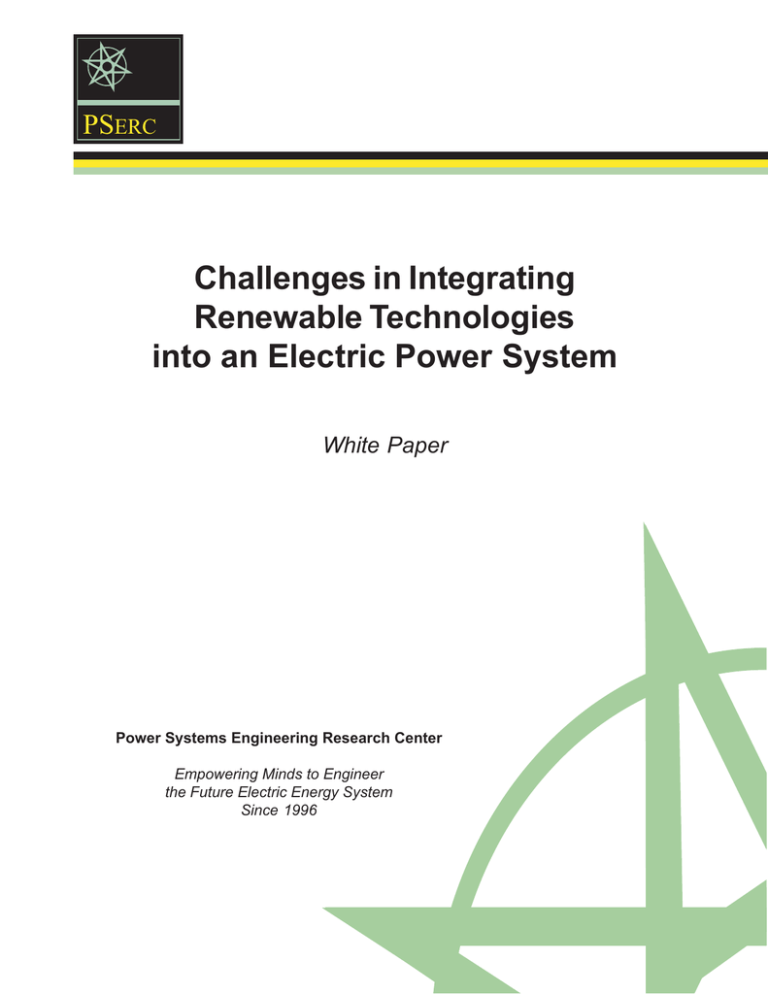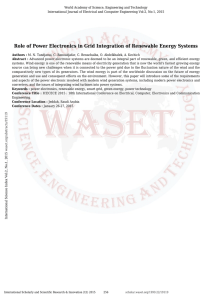
PSERC
Challenges in Integrating
Renewable Technologies
into an Electric Power System
White Paper
Power Systems Engineering Research Center
Empowering Minds to Engineer
the Future Electric Energy System
Since 1996
Challenges in Integrating Renewable Technologies
into an Electric Power System
White Paper
PSERC Executive Committee
Jerry Heydt
Arizona State Univ.
Shmuel Oren
Univ. of Calif. - Berkeley
Marija Ilic
Carnegie Mellon Univ.
P.K. Sen
Colorado School of Mines
Tim Mount
Cornell Univ.
Sakis Meliopoulos
Georgia Inst. of Tech.
James Momoh
Howard Univ.
Peter Sauer
Univ. of Illinois
Jim McCalley
Iowa State Univ.
Mladen Kezunovic
Texas A&M Univ.
Anjan Bose
Washington State Univ.
Chris DeMarco
Univ. of Wisconsin
Vijay Vittal
Director
Arizona State Univ.
Ward Jewell
Wichita State Univ.
Dennis Ray
Executive Director
PSERC Document 10-07
April 2010
Disclaimer
This white paper reflects the perspectives of the authors and not necessarily those of any of
PSERC’s industry members.
Information about this white paper
For information about this report, contact:
Vijay Vittal
Ira A. Fulton Chair Professor
Department of Electrical Engineering
Arizona State University
PO Box 875706
Tempe, AZ 85287-5706
Tel: 480-965-1879
Fax: 480-965-0745
Email: vijay.vittal@asu.edu
Power Systems Engineering Research Center
The Power Systems Engineering Research Center (PSERC) is a multi-university Center
conducting research on challenges facing the electric power industry and educating the next
generation of power engineers. More information about PSERC can be found at the Center’s
website: http://www.pserc.org.
For additional information, contact:
Power Systems Engineering Research Center
Arizona State University
577 Engineering Research Center
Tempe, Arizona 85287-5706
Phone: 480-965-1643
Fax: 480-965-0745
Notice Concerning Copyright Material
Permission is given to copy without fee all or part of this publication if appropriate attribution is
given to this document as the source material. This white paper is available for downloading
from the PSERC website.
2010 Arizona State University
All rights reserved
PSERC White Paper
Challenges in Integrating Renewable Technologies
into an Electric Power System
The U.S. is not well positioned to handle high penetrations of renewable generation technologies
due to the state of the current electric delivery grid along with its associated planning and operation criteria. This shortcoming also applies to the power engineering workforce which is only
now beginning to see topics related to integration of renewable resources being introduced in the
curriculum. Certainly there are challenges in developing renewable generation technologies, such
as reducing the capital costs and improving energy efficiencies of the various types of renewable
resources, such as wind, solar PV, solar thermal, and wave. Breakthroughs are also needed in
large-scale energy storage technologies. To seamlessly integrate renewable resources in the grid,
research and development must address challenges that high penetration levels will have in power system planning and operation, and in grid connection. Finally, the existing workforce and the
students going into power and energy engineering careers need to be educated so that they can
envision and develop the new approaches and technologies to maintain grid reliability and economy.
The challenges of integrating high penetrations of renewable energy technologies into the grid
are less well recognized in part because they require interdisciplinary research in such areas as
power systems analysis, communications, power electronics, economics, operations research,
and industrial organization. The challenges result from needed changes to achieve national and
state objectives for a low carbon energy system.
(1) Power System Planning and Risk Management: Maintaining the balance between generation
supply and real-time customer demand becomes more difficult with variable generation resources, but without large-scale, economical energy storage capacity and demand-responsive
loads. Existing planning methods, tools, metrics and standards for resource adequacy need to
be developed for an operating environment with variable generation, energy storage, demand-responsive loads, renewable energy standards, and GHG emission policies. Research is
needed to understand and respond to the implications of emerging smart grid and customerowned technologies on grid reliability. New planning and risk management tools must be developed to support decision-making in an electric system with much more uncertainty than
experienced historically.
(2) Distribution and Transmission Planning: The electric power grid is becoming an increasingly
automated network and is expected to have increased functionality, higher efficiency, more
programmability, and more flexibility. Specifications are needed for the communication networks that are interconnected to the electric grid for sensing, monitoring, and control. Increased penetration of renewables could result in low use of transmission lines unless largescale storage is available. Distributed energy resources, storage, and demand-responsive load
at the distribution level make line loading much more uncertain. Planners have to be able to
determine (1) the network topology best suited for this new operating environment, and (2)
the effects on system performance and reliability of having a large number of spatially distributed generation sources. New network topologies need to be designed to outperform traditional networks with lower transmission losses, and lower susceptibility to performance and
1
PSERC White Paper
reliability problems under contingencies. The new topologies must enable vastly increased
levels of renewable generation while considering legacy systems and incorporating emerging
technologies in HVDC, FACTS, distributed electronic power-flow controllers, and powerconversion devices for interfacing renewable resources. Protection systems must be designed
to accommodate the new operating conditions. Advances in computational methods will allow network topologies to be co-optimized as part of resource dispatch hence and network
designs must not be designed as static assets and allow for dynamic reconfiguration driven by
technical and economic objectives. Finally, new customer use and storage technologies such
as PHEV’s and EV’s pose distribution planning challenges due to increased uncertainties
about line and transformer loading.
(3) Operations: Operations (day-ahead) planning have to account for variability of renewable
resources and demand-responsive loads. Market designs must assure adequate business incentives for new generation while providing sufficient opportunities for compensation of
embedded generation owners. Increased market price variability could become an important
added risk for market participants, particularly under new environmental policies. Maintaining reliability and meeting NERC standards (e.g., for balancing and ancillary services) become difficult at high penetration levels. The standards themselves may need to be reexamined in light of new technologies and customer choices. Dynamic load control for balancing generation with load will require much higher levels of demand-responsive loads.
Wide-scale use of PHEV’s and EV’s calls for even greater management on the load side.
Applications are needed for using data from phasor measurement units (PMU’s) in wide area
monitoring systems. PMU’s effectively monitor the dynamic state of the grid, including voltage and angular stability and thermal limits, and can provide early warnings to network operators of imminent failures, stress, or potential instability, thus enabling the operators to take
preventive action. Operators of the control system of the future will have to have a new set of
decision-making tools to assure power system reliability and stability under uncertainty.
(4) Interface between the Grid and Renewables: Basic power quality requirements must be met
for harmonics, voltage, frequency, etc. for interconnecting any equipment to the grid. Renewable energy generators with their associated power electronics generate harmonics and
have electrical characteristics under voltage and frequency excursions that may make it difficult to meet those requirements. Large-scale wind farms and large-scale PV systems present
a spectrum of technical challenges arising mostly from the expanding application of power
electronic devices at high power ratings. The connection of renewables at the distribution levels also requires significant modification of the distribution design to accommodate bidirectional power flow. Facilitating the integration of distributed energy resources requires
innovations in microgrid and energy management systems that transparently provide control
and regulation.
New tools for operations and planning are needed to efficiently and effectively allow analysis
under the greater uncertainty and the diverse technology options resulting from the new generation and smart grid technologies. New operation tools are needed to incorporate renewable resources with their particular characteristics. These tools include:
•
optimal power flow studies with low to high penetration of renewable resources
2
PSERC White Paper
•
power market analysis under environmental policy constraints including low to high penetration of renewable resources
•
contingency analysis, stochastic power flow studies, dynamic security assessment and security analysis with stochastic models that capture the uncertainty of renewable resources.
•
resource scheduling algorithms that co-optimize the network topology along with resource commitment.
New tools for planning are also needed for:
•
long-term infrastructure assessment including generation planning under uncertainty,
again including short term uncertainty of renewable resources
•
distribution and transmission planning that includes locations of likely renewable resource development
•
system resource planning to accommodate all resources including generation and demand
resources while considering the structure and flexibility of the transmission topology and
higher levels of resource uncertainty.
Finally, the changes in electric energy system technologies, operation and planning methods, and
analytical tools requires an empowered education system. New students need to be ready to
make contributions when they enter jobs and existing engineers must have their skills upgraded.
It is the workforce not just the technologies that will make high penetrations of renewable technologies possible.
Conclusion
Achieving high penetration of renewable technologies with their variable generation characteristics will require many fundamental changes in the ways that electric power systems are planned
and operated to maintain reliable service and to do so economically. The National Science Foundation should be expanding its research program portfolio in the area of grid technologies. The
Department of Energy should be allocating more of its research portfolio to a systematic study of
electric power system operations and planning with high penetrations of renewable generation
technologies. Industry should be calling for and supporting more research and education on grid
integration challenges. We all need to be collaborating more to achieve the well-qualified power
and energy engineering workforce needed for planning, building, operating and maintaining the
next generation electric power system, and to manufacture the needed components of that system.
3
PSERC White Paper
References
North American Electric Reliability Corp. 2009 Long-Term Reliability Assessment: 2009-2018.
Oct. 2009.
[http://www.nerc.com/files/2009_LTRA.pdf]
North American Electric Reliability Corp. Accommodating High Levels of Variable Generation.
Special Report. April 2009.
[http://www.nerc.com/files/IVGTF_Report_041609.pdf]
PSERC White Paper. U.S. Energy Infrastructure Investment: Large-Scale Integrated Smart Grid
Solutions with High Penetration of Renewable Resources, Dispersed Generation, and Customer
Participation. March 2009.
[http://www.pserc.org/ecow/get/publicatio/2009public/]
PSERC White Paper. U.S. Energy Infrastructure Investment: Long-Term Strategic Planning to
Inform Policy Development. March 2009.
[http://www.pserc.org/ecow/get/publicatio/2009public/]
Vittal, Vijay. “The Impact of Renewable Resources on the Performance and Reliability of the
Electricity Grid. The Bridge. National Academies Press. April 2010.
[http://www.nae.edu/nae/bridgecom.nsf]
U.S. Power and Energy Engineering Workforce Collaborative. Preparing the U.S. Foundation for
Future Electric Energy Systems: A Strong Power and Energy Engineering Workforce. April
2009.
[http://www.ieee-pes.org/workforce/workforce-collaborative]
4





